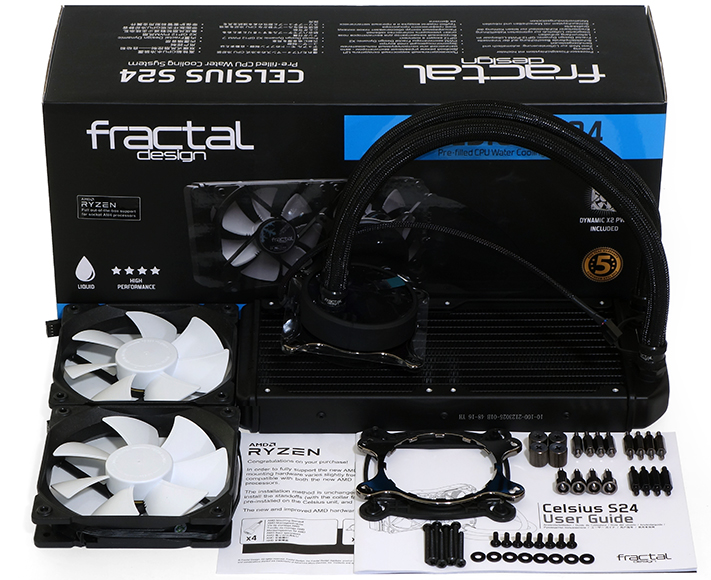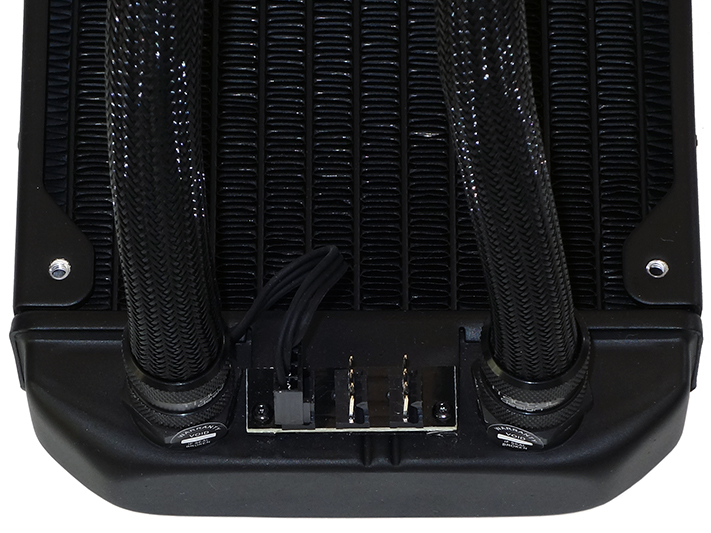Early Verdict
The best performing CPU cooler we’ve tested in two years, the Celsius S24’s low flow ratings prevent us from recommending it to the expandable kit market without further testing. Superb performance instead earns the Celsius S24 our general stamp of approval for those who only intend to use it as delivered.
Pros
- +
Best CPU cooling performance
- +
Good acoustic performance
- +
Standard G1/4 fittings for adding components
- +
Generous 5-year warranty
- +
Lowest-priced pre-filled kit
Cons
- -
No fill port
- -
Low flow rating
Why you can trust Tom's Hardware
Features & Specifications
The liquid CPU cooling market has typically been divided into low-cost/closed-loop and high-priced/open-loop configurations, but manufacturers have attempted to bring forward products that were supposed to combine the best of both worlds over the past few years. Buyers of factory-filled open loops have been able get all the convenience of a leak-free factory assembly plus the option to open it later to add components. Yet there was never a best-of-both-worlds compromise on price, because those factory-filled loops deployed premium-priced components.
Fractal Design presents potential solutions in its 2x 120mm Celsius S24 and 3x 120mm Celsius S36 kits. We got our hands on the two-fan version in time for a launch-day review.
Specifications
MORE: In Pictures: 20 Clever Liquid-Cooled PC Setups
The first thing you’ll notice in the specs is that the radiator size is just that: the size of the radiator. Unlike most pre-filled open loops, the Celsius S24 doesn’t have its pump mounted there. Instead, we find a slightly oversized version of the water-block mounted pump familiar to the closed-loop market.
The radiator and pump are still equipped with standard G1/4 fittings to allow reconfiguration, just like competing solutions. And while the Celsius S24 doesn’t include extra fittings, it does include all the hardware needed to fit it to Intel’s three most recent generations of square-ILM sockets, AMD’s legacy rectangular-pattern sockets, and the new differently-spaced AMD socket AM4 mount. AMD users will need to remove the motherboard’s clip bracket, of course.
The Intel bracket is factory installed using a twist-connect design with locking tabs. Noticing that LGA 2011, 2011-v3, and 1366 all use the same spacing, Fractal Design even included a set of holes on its CPU support plate for LGA 1366. LGA 2011 and 2011-v3 have an integrated support plate.
The AMD bracket also uses AMD’s stock support plate, though “stock” is a loose term given that multiple designs have emerged. The support plates of most legacy boards have used standardized screws for many years, though earlier designs often used alternative attachment methods where the focus was on the clip rather than the bracket that held it. Even today, some AM4 support brackets have a threaded collar that extends past the motherboard’s top surface, while others don’t.
Get Tom's Hardware's best news and in-depth reviews, straight to your inbox.
Fractal Design’s workaround for differing threaded collar heights is to include a special set of standoffs with stops that go around the collar and bottom against the board. These are polished, so they won’t scratch through the board’s protective mask and short any circuits. If you’re still more concerned about touching your delicate motherboard than mounting height, you’re free to use the traditional hardware that’s also included.
The Celsius S24 is powered at the pump, yet its braided sleeve perfectly conceals any hint of the embedded cable that runs from the pump to a breakout header for its fans. Pump speed can be regulated either by the motherboard’s PWM signal or via an internal temperature-based controller, and the pump relays its speed control to the fans. The above close-up also shows two of the four G1/4 fittings in greater detail.
Fractal Design’s Dynamic X2 GP-12 PWM fans are rated at 500-2000 RPM and a maximum 32.2 decibel (A-weighted). Fractal Design’s literature doesn’t mention the implication of a maximum of 35.2 for the pair, since doubling the number of sound sources adds 3db to a measurement.
MORE: Best CPU Cooling
MORE: How To Choose A CPU Cooler
MORE: All Cooling Content
-
ingtar33 looking good.Reply
My only question is the fans. I've loved FD cases, and owned a number, but the "stock" fans that come with those cases have been basically mediocre. While these FD fans appear to be quiet I wonder if we wouldn't see better performance and noise out of something else. -
dstarr3 Reply19672486 said:looking good.
My only question is the fans. I've loved FD cases, and owned a number, but the "stock" fans that come with those cases have been basically mediocre. While these FD fans appear to be quiet I wonder if we wouldn't see better performance and noise out of something else.
I suppose if FD must cut costs somewhere, fans are a pretty good place to do it, since they are easily replaceable. -
jcwbnimble Could this cooler's lower l/h design be giving it the advantage compared to these other expandable coolers? By that I mean, with a lower flow, the coolant has more time to release it's heat in the radiator before returning to the CPU block. These other units have much higher flow ratings, most likely because they are anticipating the addition of GPU loops, and thus push the coolant thru the radiator before it's had enough time to dissipate the stored heat.Reply
Plausible explanation for the superior cooling achieved with a lower flow rate? -
DougDigsData Just a note on "flow" rates and that higher/more is perceived as better. In thermodynamics there is an optimal rate/velocity to use. Too "fast" - not good, too "slow" - not good. For example in AC systems in our houses, the velocity of the airflow through the indoor coil is set within a range to ensure the most effective heat transmission. That could be the situation with this unit as well.Reply -
ingtar33 Reply19672609 said:Could this cooler's lower l/h design be giving it the advantage compared to these other expandable coolers? By that I mean, with a lower flow, the coolant has more time to release it's heat in the radiator before returning to the CPU block. These other units have much higher flow ratings, most likely because they are anticipating the addition of GPU loops, and thus push the coolant thru the radiator before it's had enough time to dissipate the stored heat.
Plausible explanation for the superior cooling achieved with a lower flow rate?
that's plausible, though it would mean the radiators of the other coolers are poor for dispelling heat. -
TbsToy You guys are out of your minds. You say this is the best cooler you have tested in two years and yet say it isn't expandable. It isn't designed for expandability. Not many people are interested in water cooling. W.C. is way more trouble than it is worth. Try reporting with decency instead of your screwy nonsense. Wake up. Toms hardware used to be a good tech site but has turned in to a nonsense marketing thing.Reply
Walt Prill -
RomeoReject Noob question coming up:Reply
If this is open loop, does that mean it needs to be maintained like a custom liquid cooling solution (Drained, filled, etc)? Or is it closer to a CLC in the sense it's more "mount and forget"? What's the advantage it has over either solution? -
Crashman Reply
LOL, we said it was the best performing cooler tested on the big cooler testing system, which it is. That means it beat two dozen other big coolers including several enormous air coolers and all compact liquid coolers up to and including the 2x 140mm models.19672814 said:You guys are out of your minds. You say this is the best cooler you have tested in two years and yet say it isn't expandable. It isn't designed for expandability. Not many people are interested in water cooling. W.C. is way more trouble than it is worth. Try reporting with decency instead of your screwy nonsense. Wake up. Toms hardware used to be a good tech site but has turned in to a nonsense marketing thing.
Walt Prill
There's no marketing gimmick in seeing better numbers and reporting that the numbers are the best. Something tells me you were probably once a good observer of these details but that your observations have more recently turned into a nonsense counter-marketing thing.
Eric did a special cooling project using multiple radiators on a different system. It's a full open loop. Putting all of that hardware into this system would alter the test parameters used to compare the other coolers, invalidating the comparison. But you may be interested in the components he used.
It's basically a CLLC that's had G1/4 fittings added: As long as you don't open it, it retains the CLLC basics.19673510 said:Noob question coming up:
If this is open loop, does that mean it needs to be maintained like a custom liquid cooling solution (Drained, filled, etc)? Or is it closer to a CLC in the sense it's more "mount and forget"? What's the advantage it has over either solution?
-
the nerd 389 It's interesting that you rate the acoustic efficiency of the H220-X to be almost the same as the H240-X2.Reply
That seems fundamentally wrong, considering the H240-X2 gives a delta T of 51C while producing 29.8 dBA, and the H220-X produces 34.8 dBA to achieve the same delta T.
Clearly, the H240-X2 is substantially more acoustically efficient.
This also seems to underrate the efficiency of the Fractal. It manages to achieve a lower delta T than any other cooler at max, and that means overcoming the TIM in that CPU. Each additional reduction in temperature requires exponentially more power and airflow to achieve. The more realistic comparison would be to compare cooling power at equal noise levels or comparing noise levels at equal cooling. Anything else will severely distort the data unless the non-linear relationships between fan speed/noise, fan speed/air flow, and air flow/thermal conductivity are accounted for. -
mpampis84 Does it perform better than the Kelvin S24 though? Kelvin prices have dropped recently, so is there any point in waiting for Celsius, apart from the integrated fan hub?Reply






